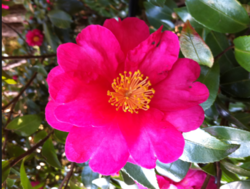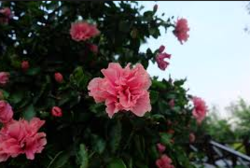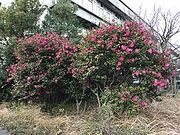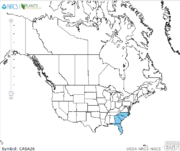Sasanqua camellia
| Sasanqua camellia |
|---|

|
| Scientific Classification |
|
| Scientific Name |
|
Camellia sansaqua |

|
| Picture of Camellia Sasanqua |
Sasanqua camellia is a species of flowering evergreen shrub known by the scientific name Camellia sansaqua, and commonly referred to simply as Sasanqua. In Japanese, they call it tsubakki(つばき) and in Korean, dongbaek-kkot(동백꽃). Sasanqua prefers to live in the subtropical areas. It was first introduced in Japan and they expanded throughout East Asia. It starts to bloom in mid-fall and enters a period of dormancy in early summer. They are very unique in that the color of flower changes gradually when the season changes, and if wind blows or other forces impact the flower, they do not fall down by single petal, but entire flower will drop.
Body Design
Sasanqua is an evergreen shrub that usually grows at the beginning of December during cold winter until April. The size of the shrub depends on which environment it lives in but generally when it grows in the subtropical area. It grows up to 5 m tall. The leaves are broadly elliptic, 7 cm long and 3 cm wide, with a fine margin. The flowers are 6cm in diameter, with five to eight white to dark pink petals.[2]
Life Cycle
As Sasanqua is a flowering plant, which means angiosperm, its reproduction is by pollination and fertilization. It reproduces sexually with male and female reproduction by pollination and fertilization. During Fertilization, sporangium, inside of anther fertilize microspore, "mother cell" begins meiosis. The mother cell separates into two cells, generative cell, and tube cell, and form an individual sperm through pollen tube. The other way of reproduction cell pollination in Camellia is a female reproduction of ovary. The macrospore ovule in ovary creates polar nuclei, egg, and synergid during meiosis and mitosis. These three factors form a sperm and the sperm which was created by pollination or fertilization makes a seed into plant [3]
Ecology
Sasanqua is native to Japan and they are found in eastern and southern Asia, from East Asia to Japan and Indonesia and Korea because of the geographic feature of these countries. It only grows in the subtropical region. Japan, formed of 6,852 islands along the coast including four main islands. Also, Indonesia has 17,508 islands in the subtropical area. This geographic feature is highly recommended for Sasanqua to grow in thrive. It needs sunlight with 20-30 degree Celsius in order to develop its structures. Therefore, They require good soil, present in moisture, and morning sunlight.[4] It grows along the coast and also it grows in thickets and on grassy slopes in mountains. Its found on southern Shikoku Island, Kyushu Island, Yaku-sima Island and the islands south to the Liu Kiu Islands in Japan. It can be also found in Jeju island in Korea.[5]
How to grow Camellia Sasanqua
The first thing you have to know about the S. Camellia is that they grow in cool weather environment. You need to consider the environment where you want to plant on. If environments are provided in appropriate conditions, they will definitely thrive. Second, you need to determine which period of the season to start gardening. Camellia Sasanquas bloom from fall to early winter and if you start gardening beginning in the fall, you will see the flowers are blooming as soon as possible. Third, Camellia Sasanqua requires acidic soil but they do not grow well in soils with a high acidic soil and will exhibit signals of stresses such as changing in different color, especially yellow leaves are critical or some visual weakness of flowers.
You need to manage them inside their optimal range such as light, soil, and moisture. If you place Camellia Sasanqua on the North side of your house in order to photosynthesis morning sunlight and avoid hot afternoon sunlight will make the flower faster and healthier in growth. Eventually, they will adapt the afternoon sunlight when it becomes mature. As they become mature then their thick canopy of leaves shades cool their roots. For Camellias well-drained soil is essential for them but they do not tolerate wet feet.[6]
Camellia Sasanqua only need water when the soil gets extreme drought. In general, they barely need water when they are 3 years old or older. When you fertilize them, check whether flowers have completely dropped if the flowers are dropped and then feed with an acid-forming camellia fertilizer in spring. You better need to fertilize again in the mid-summer when they look sluggish, foliage, and it begins to lose it's deep green color leaves. Make sure do not over fertilize and do not fertilize after August because Camellia Sasanqua will be entering into the period of dormancy.
Fun Facts
Koreans had a superstition that if a person plants this flower in front of the door or in his house, the flower will bring misfortune to the owner. They thought it would because falling of flowers seemed like cutting a head off. Camellia Sasanqua has some words for the flower. The red petal flower means "the desirable love" and the white pedal means "lovely love(secret love)". Even though it is the same flower, people have different perspectives on the flower. Camellia Sasanqua frequently used in Korean poems and Korean traditional songs.[7]
Video
The video shows the other kinds of Camelia Sasanqua that has different color and organized by its diversity in color and shape. Also, the video contains body design, environment, the method to grow Camellia Sasanqua. Surprisingly, even though they are all Camellia Sasanquas the structures are each different from others.
References
- ↑ USDA PLANTS
- ↑ Camellia Sasanqua Wikipedia. Web. last modified on January 9th, 2018. Author Unknown
- ↑ Camellia Wikipedia. Web. last modified on January 2nd, 2018. Author Unknown
- ↑ Camellia Sasanqua Namu-wiki. Last modified Jan 5th, 2018. author unknown.
- ↑ Camellia Sasanqua iucnredlist. Web. accessed on Jan 31, 2018. author unknown.
- ↑ How to grow Camellias Monrovia. Web. Accessed on Jan 31, 2018. author unknown.
- ↑ 동백꽃 지식백과(knowledge wiki). Web. accessed on Jan 31, 2018. author unknown



